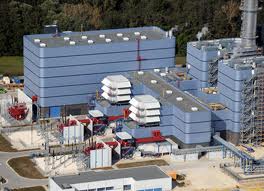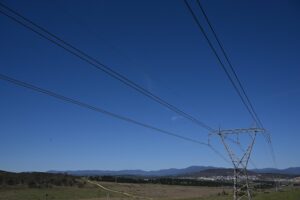On May 17, 2010, E.ON, the biggest electricity utility in Germany, opened a brand new 860MW combined cycle gas-fired power station in Bavaria, which it had built at a cost of $520 million. Less than three years later, having hardly been used and losing money, the owners of Irsching-5 (pictured below) are threatening to close it.
 It’s just one illustration of the dramatic changes that are sweeping the European energy industry because of the growing impact of wind and solar, and falling demand. E.ON this week said it was thinking of closing 13GW of coal and gas-fired generation in coming years – but it may be only a fraction of what is needed.
It’s just one illustration of the dramatic changes that are sweeping the European energy industry because of the growing impact of wind and solar, and falling demand. E.ON this week said it was thinking of closing 13GW of coal and gas-fired generation in coming years – but it may be only a fraction of what is needed.
Officially, 21 coal, gas and oil-fired plants have been slated for closure out to 2017 in the central European energy market – which includes Germany, France, Belgium, Austria, Switzerland and the Netherlands. This represents about 7GW of capacity, and is over and above the 6GW of anticipated nuclear retirements in Germany and Belgium over the same period.
But according to the European energy team at UBS, this may just scratch the surface of what’s needed – and a further 41GW (19GW of coal and 22GW of gas) may have to be closed to restore the industry to profitability and offset the “downside” to centralised generation created by the renewables boom.
That would bring total closures of coal and gas plants over the coming four years to 49GW (around a third of total thermal capacity) – which just happens to match the amount of wind and solar capacity that UBS anticipates will be added over the same period.
UBS says the central European market is in rapid decline because of falling demand, the construction of too much conventional generation capacity, and a low Co2 price. But it says the most important driver has been the “remarkable” increase of renewable capacity, and in particular solar, mainly in Germany.
Solar, as is noted in a previous report about the solar “revolution”, is “cannibalising” the earnings of the centralised generators, which are unable to cut their output to changing demand conditions, and will be increasingly exposed to times when they have to generate power when the fuel cost is higher than the spot price.
It says this means brown coal and nuclear generating capacity could fall quicker than most people would expect from the average increase in solar and wind. Indeed, its conclusion that the required closure of thermal capacity would need to match the increase in wind and solar would go against most traditional views of the workings of the energy, but such is the impact of the changing dynamics brought about by renewables.
The UBS analysis goes through a range of scenarios in its “base case” – including the addition of 49GW of wind and solar in the next five years, the closure of 6GW of nuclear, and 25GW of coal and gas – about three times what has already been announced. And it assumes relatively stable prices for carbon, coal, gas and oil.
This base case scenario shows relatively stable baseload prices, but peak prices plunge because of the increasing “cannibalisation” from solar power. (Peak pricing provides much of the positive cash flow for generators).By 2020, UBS predicts, the gross margin for coal-fired generation is around zero and the capacity factors of the plants – the percentage of time they are used – falls dramatically: brown coal to 66 per cent from 73 per cent, black coal to 37 per cent from 47 per cent, and gas to 18 per cent from 30 per cent.
UBS then runs a range of more aggressive scenarios to see what it takes to return the sector to profitability.
Even assuming a 5 per cent peak capacity rating for wind, and zero for solar (which kind of goes against its previous conclusions on peak pricing), UBS says that at least 30 per cent of the central European coal fleet and 30 per cent of the gas fleet need to close just to maintain cash flows at the depleted 2012 levels. A closure rate of 40 per cent is required to boost earnings, and to stabilize the cash flows of the remaining nuclear plants. A closure rate of up to 50 per cent is also modeled.
UBS, however, doesn’t see this as a practical or likely solution, as it predicts orderly closures are unlikely to happen – firstly because energy market regulators would be concerned about declining capacity (the 40 per cent closure scenario takes reserve margins down below 10 per cent), and could intervene to prevent them.
The second reason is because the generators themselves would keen to gain the “free rider” bonus that comes with being the last one closed: the “prisoner’s dilemma” of not wanting to take action first, just as in broader climate change action. “Thus the downside just continues,” UBS says.
Although the markets in central Europe are different to those in Australia, a lot of the same dynamics will play on Australian generators. Already, the impact of reduced demand, growing renewables, and rooftop solar, is causing a decline in output in coal generation, bringing capacity factors down sharply, particularly for black coal generators. Some 3,000MW of capacity has already been mothballed. And gas fired generators face rising commodity costs in coming years as the LNG plants come on stream, and domestic gas prices rise to match export prices.
UBS is pessimistic about the future of centralised thermal generation in central Europe. “(It) is in structural decline,” it notes, and adds that it has taken place at “remarkable” speed. “We do not think that closures will save the European power generation downside.”
It has sell recommendations on all the major power utilities with large exposure to coal and gas fired generation. Many of these companies have high debt levels, the result of recent merger activity, but they have been caught out by falling demand and the rush to wind and solar.
A Reuters report last week noted that the centralised production model risked becoming “dinosaurs” of the energy market unless they reinvented themselves soon. These utilities are now starting to focus on decentralized energy, renewables, and energy efficiency. E.ON says it will focus its investments in that sector, and GDF Suez, whose CEO has talked of a “revolution” in the industry caused by solar, is doing the same.
The problem is that most of these companies are already behind other first movers. They own just 7 per cent of renewables capacity and less than three per cent of solar capacity.
“Utilities produce electricity, and here’s a new technology for producing electricity, and they are not in there. They have completely missed the opportunity,” Lueneburg University researcher Mario Richter told Reuters.
Laszlo Varro, an economist with the International Energy Agency, says utilities could benefit greatly if they did not treat rooftop solar as competition for their thermal plants but as a gateway into that new market. “In a future electricity system, the electricity network company could essentially be an insurance company, providing insurance against not having sunshine when you need power,” he told Reuters.
There’s a lesson there for Australian utilities.








